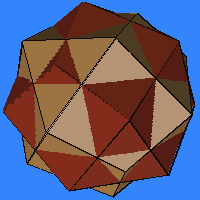Tetrahedrally Stellated Icosahedron
This is a polyhedron (or three) which I just happen to like, so I thought it should get its own web page. I've never seen it described anywhere, so I wasn't sure what to call it, but tetrahedrally stellated icosahedron seems reasonable. I didn't put a picture here because a 2D image doesn't do it justice. Play with one, make one, and you'll get to like it too. It has 16 faces (4 equilateral triangles and 12 kite-shaped faces), 30 edges, and 16 vertices.
To understand it, choose four faces of an icosahedron in the planes of a tetrahedron. (Recall how the icosahedron can be inscribed into an octahedron and an octahedron can be inscribed into a tetrahedron. Or, just select all four faces of any one color from this 5-colored icosahedron, e.g., the four blue faces.) Next, cover each of the four chosen faces with a low triangular pyramid. The pyramid height is chosen so its sides are a continuation of the adjacent faces of the icosahedron. Thus four of the icosahedron faces are eliminated and twelve are extended into kite-shaped quadrilaterals. Another four faces, of the original 20, remain unchanged. This is the tetrahedrally stellated icosahedron. (In terms of the 59 stellations of the icosahedron, this is like the first stellation, but only four faces are covered instead of all 20.)
One interesting thing about this polyhedron is its symmetry group; it has tetrahedral symmetry, but is chiral. Thus, it has the axes of symmetry of a tetrahedron, (four 3-fold axes and six 2-fold axes,) but no planes of symmetry. It is the simplest such polyhedron.
If you want to make a paper model you can construct a face knowing the following. From an icosahedron with edge-length of one, the kite-shaped faces have edges of length 1 and 0.6325. The angle between the longer sides of the kite edges is still 60 degrees (from the underlying icosahedron.) You need twelve such kites and four equilateral triangles of edge 1.
Another interesting thing about this polyhedron is that it has the same net as its dual. The dual operation to stellating four faces of the icosahedron is truncating four vertices of the dodecahedron. Choose four which are at the vertices of a tetrahedron inscribed in the dodecahedron., and maximally truncate those four corners of the dodecahedron to get this tetrahedrally truncated dodecahedron. Notice it has the same arrangement of 16 faces, 16 vertices and 30 edges. Geometrically it is different in that the quadrilaterals are trapezoids rather than kite-shaped, but topologically it is identical. This is another nice model, with the same symmetry group. It is easy to make in paper since the trapezoids are just regular pentagons cut along a diagonal.
Now for the good part. We can construct a version which is halfway between the tetrahedrally stellated icosahedron and the tetrahedrally truncated dodecahedron, and which is geometrically self-dual. This is achieved by a process which creates canonical polyhedra. The result is a self-dual 16-sided polyhedron. (I don't know what to call it.)
If you want to make a paper model, the kite faces have edges in the ratio 1 to 0.803, and the angle between the long sides is 82.96 degrees.
 You
can see more of it at once (the front and the back at the same time) in
this compound of the
self-dual 16-sided polyhedron with itself.
You
can see more of it at once (the front and the back at the same time) in
this compound of the
self-dual 16-sided polyhedron with itself.
I don't know if these things are described or given names anywhere. I don't recall ever seeing any of this in print anywhere. So, if you know of or run across a reference to them, please let me know. The name "tetrahedrally stellated icosahedron" could probably be improved upon, because in most stellations, all the underlying face planes show up as exterior faces, while here only sixteen of the underlying twenty do, so the result is not an icosahedron. Incidentally, if we also stellate over the four faces opposite to the four chosen in this tetrahedrally stellated icosahedron, we get a stellation of the icosahedron with only twelve external faces. The result is a tetrahedral stellation of the icosahedron which is a dodecahedron. (It is a form of pyritohedron mentioned on the dodecahedra page.)
After finding this one, I decided to make lots of other stellations
of the icosahedron with tetrahedral symmetry.